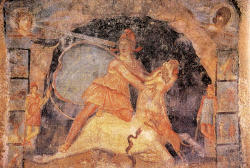Mithras Grotto
Mithraeum

A mithraeum is a temple of the cult of the Persian god of light or sun-god Mithras or Mitra. Typically those temples are built underground, which is a principle of this religion. During Roman times many thousands of those cave temples existed in Europe. The Romans were rather tolerant and allowed other religions, probably a result of the fact that they had a polytheistic religion anyway. But later, mainly because of the Christians, the Mithras cult was pursued and most temples destroyed. About 450 temples were excavated, but only very few temples are still in their original form.
The reason why those temples are always underground is the legend about the god Mitra killing a bull. According to the legend Mithras hunted the bull, overwhelmed its strength, then rode it and led it into a cavern, where he killed it. This scene is depicted in many Mithras Grottos, and is called a tauroctony.
Mithras temples are always small, with two benches along the left and right side, which can hold not more than 40 people. It seems when the number of worshippers increased the number of services and/or the number of temples was increased, but not the size. In the wall at the far side, opposite the entrance, a depiction of Mithras, a tauroctony, is the sactuary. In front of it there was often a pedestal-like altar. The room is underground if possible, but always it is completely dark, there are no openings or windows. It is called spelaeum or spelunca which means cave. The benches are interpreted as the place where worshippers were siting during the service, but also during common meals or ritualistic meals.
In 391, the edict of the emperor Theodosius prohibited the worship of all pagan gods, thus forbidding the Mithras cult. This caused the destruction of Mithras temples throughout Europe. Later the mithraeae were given other names, a result of the ignorance of later generations. They were named pagan church or church of the wild women, but those names were used for any kind of ancient temple.
- Examples
 Mithraeum
Mithraeum Mithrasgrotte
Mithrasgrotte Heidenkapelle
Heidenkapelle Caverna del Dio Mithra
Caverna del Dio Mithra Mithraeum San Clemente
Mithraeum San Clemente Mitreo di Palazzo Barberini
Mitreo di Palazzo Barberini Reise Cave
Reise Cave Santa Prisca Mithraeum
Santa Prisca Mithraeum Mitreo delle Terme del Mitra
Mitreo delle Terme del Mitra
 Search DuckDuckGo for "Mithras Grotto"
Search DuckDuckGo for "Mithras Grotto" Mithraeum - Wikipedia (visited: 21-MAY-2020)
Mithraeum - Wikipedia (visited: 21-MAY-2020) Mithraism - Mithraic Mysteries (visited: 21-MAY-2020)
Mithraism - Mithraic Mysteries (visited: 21-MAY-2020)
 Index
Index Topics
Topics Hierarchical
Hierarchical Countries
Countries Maps
Maps